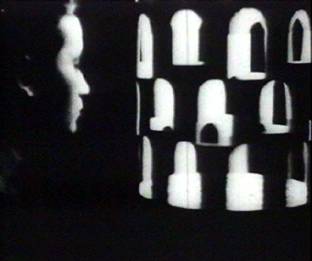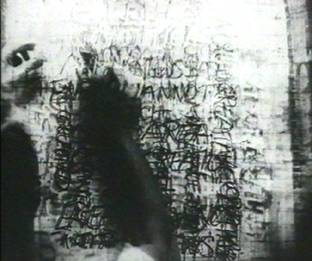|
The first film works Burroughs was involved in are
also the ones he had the most involvement in. These were
the collaborative avant-garde films of the 1960's, the same
period as the development of many of the literary techniques
and concepts just mentioned. It is easy to see this when
analysing the works.
The
films in question are Towers Open Fire and The Cut-Ups, both directed by British
film maker and independent distributor Antony Balch, who
Burroughs and Gysin became friends with at the Beat Hotel.
Balch was just the person the two of them were looking for
to translate their concepts into the medium of film. Burroughs
and Gysin were highly partial to experimentation in all
forms of the arts, and it was not long until the three of
them as well as Ian Somerville teamed up and began to explore
the cinematic potential of their ideas.

Towers
Open Fire was the first film to be made, shot between
1961 and 1962, and was mainly a collaboration between Burroughs
and Balch, although Somerville and Gysin are credited and
their influences do appear in the film in some form. It
is a black and white, hand held (shot by Balch himself),
encoded structural piece that is "a cinematic interpretation
of many of Burroughs' major themes." (p.170, Sargeant,
2001) As Sargeant goes on to say, it is not a cut-up
itself, although it does contain the first evidence of the
technique being applied directly to film (as The
Cut-Ups expands on) in a short cut-up sequence
shot on a quayside in Paris.
A
"collage of the main themes and situations or 'routines'
that appear in Burroughs cut-up novels of the period"
(Bridgett, date unknown), Towers portrays
"the destruction of the stock market and disintegration
of the Board", as described by Sargeant. This is shown
by Burroughs himself in camouflage and a gas mask, brandishing
an 'orgasm gun' and shooting photographs of families and
stereotypical images of social happiness. Effectively destroying
the pictorial form of language and the conventional representation
of happiness. When Burroughs commands "Towers open
fire!", sound waves are emitted by antennae to attack
the Boards' senses.
When these weapons are deployed 'The Board', a group of
suit wearing men sitting around a table, with pictograms
and Egyptian symbols pinned to the wall in the background,
dissolve and disappear. This is Burroughs' notion of 'control'
being broken down, and with it these scenes are intercut
with "various other images of autonomous liberation."
(p.170, Sargeant, 2001) These are such images as
Balch masturbating and Burroughs waving his hands magically
over film canisters.
We
are then left with the resolution of photographs and the
Boards papers blowing away, connoting the end of their rule
and with it their mode of communication. Here we see an
exact example of Burroughs war against 'control' as well
as his distain for conventional language. The icons of weaponry
are there with the 'orgasm gun', a sexual weapon (connoting
the sexual aggression present in Burroughs writing), and
the towers themselves as a powerful sonic weapon in Burroughs
arsenal, and another incarnation of his combating of 'control'/the
Board by sensory assault. It is backed up by shots of Burroughs
holding a tape recorder. This idea of sonic warfare returns
in his writings later in the decade and goes on to influence
music and film alike, as will be discussed later.
Yet
it is not only the connoted themes and ideas of Burroughs'
literature that are present in Towers,
it contains within the voiceover (Burroughs himself, once
again) a brief passage from the 1966 edition of The
Soft Machine, to add further strength to Burroughs'
stamp on the movie as well as a direct link to his literature.
When
deconstructed in this way it is clear to see Burroughs'
concepts within this work. There are other key elements
in this film that also feature in the other of this period,
generally because much of what was shot was used interchangeably
in the films. This is characteristic of Burroughs methods
as he often overlapped work in novels and included material
written long ago in newer writings (the title 'Towers Open
Fire' was used as a chapter heading in Nova Express written after the film was made). Plus all these films were
shot in many different locations, giving the Beat sense of travel and constant movement that was true their
nature whilst filming. Also the appearance of Burroughs
himself in all the films refers to the 'slipstream' idea
elaborated on from Sargeants' book. Gysins invention of
the 'Dreamachine' appears in both Towers and The Cut-Ups, which is another tool
to achieve the mental liberation that their practises are
meant to encourage.
The
second film, The Cut-Ups, although not
such an involved and encoded piece as Towers,
it is still very relevant in its application of Burroughs'
work in film. This was a more extreme experiment with less
narrative to extract and was a wider collaboration than Towers as it involved Gysin and Somerville
more than its predecessor. Much of the footage used in The
Cut-Ups was originally shot between 1961 and 1965,
amongst the footage used in Towers, for
a silent documentary to be entitled 'Guerrilla Conditions'.
This film was never fully realised so they used what they
had shot for it for The Cut-Ups, once again
merging two texts, one never accomplished and used as a
tool to create something new.

Although
this collective had never really expressed an interest in
the avant-garde movements present at the time they wanted
to achieve something similar to the structural films of
the New York, and various other, co-op groups, and with
the use of the newly developed cut-up technique they had
the perfect tool to create an original piece. The film is
a montage of various routines at various speeds; Burroughs
walking around, someone dancing in the street, Gysin painting,
the Dreamachine, Burroughs dressed as a doctor examining
a boy etc, with each shot an equal length (with the exception
of the last). These scenes do not cut together to form a
narrative, more an abstract montage, putting it into the
structural film bracket. It was an exact science, as Balch
wanted each scene to be just long enough for the audience
to take in:
"I
asked myself what was the shortest length that anyone
could really take a scene in, shorter than a foot
not everyone could see everything, longer than a foot
and they'd have time to examine it." (p.12,
Cinema Rising #1, 1972)
He also experimented with speeds of film, showing it at
16 frames a second on occasions, to further disorientate
the viewer.
Each scene was originally conventionally edited to create
a basic narrative scenario, it was then that the cut-up
method was employed. After cutting the film into four approximately
equal lengths and then into foot long strips, Balch had
these pieces randomly stuck together by an employee to construct
what we see as The Cut-Ups now*. By literally cutting up
the footage and randomly sticking it back together, taking
away the purposeful construction of a considered edit, it
is a direct filmic interpretation of the literary cut-up.
Although
this was not the only avant-garde method applied and the
use of sound gives the film a dimension literature could
not achieve. The image is supported by a layered, voiceover
engineered by Somerville, with Burroughs and Gysin repeating
the permutated phrases, "Yes/Hello/Look at that picture/Does
it seem to be persisting?/Good/Thank You". These are
instructions from a Scientology auditing test. The soundtrack
was made totally independently of the image but runs for
exactly the same amount of time. It serves to add another
layer of disruption, as the audience is not used to hearing
language utilised in such an abstract way, divorced from
the picture. Although, it does link formically with the
thematic concepts of the piece. A strange union present
in Burroughs writing.
So,
where Towers and The Cut-Ups differ is the former connotes Burroughs concepts through
representation (save the brief cut-up section), whereas The Cut-Ups is a formic exercise in bringing
the cut-up technique in full into film "to make explicit
a psycho sensory process" as Burroughs describes in The Third Mind. Unfortunately at the time this
was not really acknowledged as the films were not shown
to wide audiences (The Cut-Ups was cut
down from 23 minutes to 12 then subsequently withdrawn form
where it was first shown because members of the audience
were leaving things behind in the cinema in their confusion
after seeing the film!). Also they were not embraced by
the avant-garde contingent that should have supported them.
When Burroughs returned to New York the co-op of Jonas Mekas
and Adams-Sitney shunned them because their collective's
"reputation was too heavy"** since, "William
had shot his wife and he had published the most shocking
book of all time."*** So it is only in recent years
(thanks to P-Orridge, as is written later) that these films
have obtained their due recognition as relevant 1960's avant-garde
works.
* A similar method was used to create the cut-up sequence in Towers Open Fire.
** Brion Gysin interview (Cantrill, 1984)
*** Ibid.
<< | introduction | part 1 | part 2 | part 3 | part 4 | >>
|